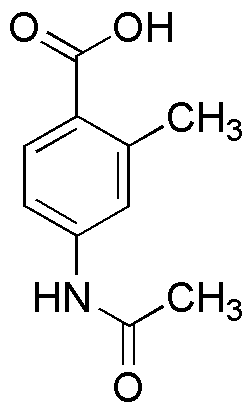4-Acetamido-2-methylbenzoic acid is widely utilized in research focused on:
- Pharmaceutical Development: This compound serves as a key intermediate in the synthesis of various analgesics and anti-inflammatory drugs, providing effective pain relief with fewer side effects compared to traditional NSAIDs.
- Biochemical Research: It is used in studies investigating enzyme inhibition and metabolic pathways, helping researchers understand disease mechanisms and develop targeted therapies.
- Analytical Chemistry: The compound is employed as a standard in high-performance liquid chromatography (HPLC) for the quantification of related substances in complex mixtures, ensuring accuracy in analytical results.
- Polymer Science: It can be incorporated into polymer formulations to enhance thermal stability and mechanical properties, making it valuable in the production of durable materials.
- Cosmetic Industry: The compound is explored for its potential as a skin-conditioning agent, offering moisturizing benefits while being gentle on the skin, making it suitable for sensitive formulations.
General Information
Properties
Safety and Regulations
Applications
4-Acetamido-2-methylbenzoic acid is widely utilized in research focused on:
- Pharmaceutical Development: This compound serves as a key intermediate in the synthesis of various analgesics and anti-inflammatory drugs, providing effective pain relief with fewer side effects compared to traditional NSAIDs.
- Biochemical Research: It is used in studies investigating enzyme inhibition and metabolic pathways, helping researchers understand disease mechanisms and develop targeted therapies.
- Analytical Chemistry: The compound is employed as a standard in high-performance liquid chromatography (HPLC) for the quantification of related substances in complex mixtures, ensuring accuracy in analytical results.
- Polymer Science: It can be incorporated into polymer formulations to enhance thermal stability and mechanical properties, making it valuable in the production of durable materials.
- Cosmetic Industry: The compound is explored for its potential as a skin-conditioning agent, offering moisturizing benefits while being gentle on the skin, making it suitable for sensitive formulations.
Documents
Safety Data Sheets (SDS)
The SDS provides comprehensive safety information on handling, storage, and disposal of the product.
Product Specification (PS)
The PS provides a comprehensive breakdown of the product’s properties, including chemical composition, physical state, purity, and storage requirements. It also details acceptable quality ranges and the product's intended applications.
Certificates of Analysis (COA)
Search for Certificates of Analysis (COA) by entering the products Lot Number. Lot and Batch Numbers can be found on a product’s label following the words ‘Lot’ or ‘Batch’.
Numéro de catalogue
Numéro de lot/série
Certificates Of Origin (COO)
This COO confirms the country where the product was manufactured, and also details the materials and components used in it and whether it is derived from natural, synthetic, or other specific sources. This certificate may be required for customs, trade, and regulatory compliance.
Numéro de catalogue
Numéro de lot/série
Safety Data Sheets (SDS)
The SDS provides comprehensive safety information on handling, storage, and disposal of the product.
DownloadProduct Specification (PS)
The PS provides a comprehensive breakdown of the product’s properties, including chemical composition, physical state, purity, and storage requirements. It also details acceptable quality ranges and the product's intended applications.
DownloadCertificates of Analysis (COA)
Search for Certificates of Analysis (COA) by entering the products Lot Number. Lot and Batch Numbers can be found on a product’s label following the words ‘Lot’ or ‘Batch’.
Numéro de catalogue
Numéro de lot/série
Certificates Of Origin (COO)
This COO confirms the country where the product was manufactured, and also details the materials and components used in it and whether it is derived from natural, synthetic, or other specific sources. This certificate may be required for customs, trade, and regulatory compliance.


